Cardiovascular Activity of the Chemical Constituents of Essential Oils
Abstract
1. Introduction
2. Results and Discussion
2.1. Thymoquinone
2.2. Cinnamaldehyde
2.3. Cinnamic Acid
2.4. Cinnamyl Alcohol
2.5. α-Bisabolol
2.6. Carvacrol
2.7. Borneol
2.8. Carvone
2.9. Eugenol
2.10. 1-Nitro-phenylethane
2.11. Auraptene
2.12. Citral
2.13. Citronellal
2.14. Farnesene
2.15. Limonene
2.16. Linalool
2.17. Linalyl Acetate
2.18. Menthol
2.19. N-Butylidenephthalide
2.20. Rotundifolone
2.21. α-Terpineol
2.22. 1,8-Cineole
3. Conclusions
Acknowledgments
Author Contributions
Conflicts of Interest
Abbreviations
| AID | Alfa (α) Interaction Domain |
| BP | N-Butylidenephthalide |
| BS | (−)-α-Bisabolol |
| CAL | Cinnamyl Alcohol |
| Cavβ2a | β-Subunit isoform of voltage-gated L-type Ca2+ channel |
| cGMP | Cyclic guanosine monophosphate |
| CK-MB | Creatine kinase MB |
| CVD | Cardivascular diseases |
| DOCA | Deoxycorticosterone acetate |
| EC | Cultured vascular endothelial |
| EDHF | Endothelium-Derived Hyperpolarizing Factor |
| eNOS | Endothelial NO Synthase |
| EOAR | Rosewood Oil |
| GR | Glutathione Reductase |
| GSH/GSSG | Reduced or Oxidized Glutathione ratio |
| HUVEC | Human Umbilical Vein Endothelial Cells |
| IK | Active Intermediate |
| IL-1β | Interleukin 1β |
| IL-6 | Interleukin 6 |
| iNOS | Inducible NO Synthase |
| LA | Linalyl Acetate |
| LDH | Lactate Dehydrogenase |
| l-NAME | N(ω)-Nitro-l-Arginine Methyl Ester |
| LO | Linalool |
| MAP | Mean Arterial Pressure |
| MI | Myocardial Injury |
| MOVAS | Mouse Vascular Smooth Muscle |
| NCD | Non Communicable Diseases |
| NO | Nitric oxide |
| NP | 1-Nitro-Phenylethane |
| Nrf2 | NF-E2-related factor 2 |
| PKG | Protein Kinase G |
| RAS | Renin-angiotensin Aldosterone System |
| ROC | Receptor Operator Channels |
| ROS | Reactive Oxygen |
| SBP | Species Systolic Blood Pressure |
| SK | Small-conductance Ca2+-activated K+ |
| SKCa/IKCa | Calcium Activated Potassium Channels |
| SOCs | Store Operator Channels |
| SOD | Superoxide Dismutase |
| TBARS | Thiobarbituric Acid Reactive Substances |
| TEA | Tetraethylammonium |
| TNF-α | Tumor Necrosis Factor alpha |
| TQ | Thymoquinone |
| TRPA1 | Transient Receptor Potential Ankyrin 1 |
| TRPV | Transient Receptor Potential Vanilloid |
| VCM | Ventricular Cardiac Myocytes |
| VOCC | Voltage-Operated Calcium Channel |
| VSMC | Vascular Smooth Muscle Cells |
References
- World Health Organization. Global Health Estimates: Deaths by Cause, Age, Sex and Country. Available online: http://www.who.int/healthi nfo/global_burden_disease/en/ (accessed on 3 May 2017).
- World Health Organization. Global Status Report on Noncommunicable Diseases 2014. Available online: http://apps.who.int/iris/bitstream/10665/148114/1/9789241564854_eng.pdf?ua=1 (accessed on 3 May 2017).
- Matthew, J.R.; Kaye, A.D. Complementary and alternative medicine and cardiovascular disease: An evidence-based review. Evid. Based Complement. Altern. Med. 2013, 2013, 1–8. [Google Scholar]
- Newman, D.J.; Cragg, G.M. Natural products as sources of new drugs from 1981 to 2014. J. Nat. Prod. 2016, 79, 629–661. [Google Scholar] [CrossRef] [PubMed]
- Vinson, J.A.; Dabbagh, Y.A.; Serry, M.M.; Jang, J. Plant flavonoids, especially tea flavonols, are powerful antioxidants using an in vitro oxidation model for heart disease. J. Agric. Food Chem. 1995, 43, 2800–2802. [Google Scholar] [CrossRef]
- Dandona, P.; Ghanim, H.; Brooks, D.P. Antioxidant activity of carvedilol in cardiovascular disease. J. Hypertens. 2007, 25, 731–741. [Google Scholar] [CrossRef] [PubMed]
- Korantzopoulos, P.; Kolettis, T.M.; Galaris, D.; Goudevenos, J.A. The role of oxidative stress in the pathogenesis and perpetuation of atrial fibrillation. Int. J. Cardiol. 2007, 115, 135–143. [Google Scholar] [CrossRef] [PubMed]
- Suen, J.; Thomas, J.; Kranz, A.; Vun, S.; Miller, M. Effect of flavonoids on oxidative stress and inflammation in adults at risk of cardiovascular disease: A systematic review. Healthcare (Basel) 2016, 4, 69. [Google Scholar] [CrossRef] [PubMed]
- Cunha, F.V.; Gomes, B.S.; Neto, B.S.; Ferreira, A.R.; De Sousa, D.P.; De Carvalho Martins, M.C.; Oliveira, F.A. Ferulic acid ethyl ester diminished Complete Freund's Adjuvant-induced incapacitation through antioxidant and anti-inflammatory activity. Naunyn-Schmiedeberg’s Arch. Pharmacol. 2016, 389, 117–130. [Google Scholar] [CrossRef] [PubMed]
- Pires, L.F.; Costa, L.M.; De Almeida, A.A.; Silva, O.A.; Cerqueira, G.S.; De Sousa, D.P.; De Freitas, R.M. Is there a correlation between in vitro antioxidant potential and in vivo effect of carvacryl acetate against oxidative stress in mice hippocampus? Neurochem. Res. 2014, 39, 758–769. [Google Scholar] [CrossRef] [PubMed]
- Rocha, N.F.; Oliveira, G.V.; Araújo, F.Y.; Rios, E.R.; Carvalho, A.M.; Vasconcelos, L.F.; Macêdo, D.S.; Soares, P.M.; De Sousa, D.P.; Sousa, F.C. (−)-α-Bisabolol-induced gastroprotection is associated with reduction in lipid peroxidation, superoxide dismutase activity and neutrophil migration. Eur. J. Pharm. Sci. 2011, 44, 455–461. [Google Scholar] [CrossRef] [PubMed]
- Silva, M.I.; Silva, M.A.; De Aquino Neto, M.R.; Moura, B.A.; De Sousa, H.L.; De Lavor, E.P.; De Vasconcelos, P.F.; Macêdo, D.S.; De Sousa, D.P.; Vasconcelos, S.M.; et al. Effects of isopulegol on pentylenetetrazol-induced convulsions in mice: possible involvement of GABAergic system and antioxidant activity. Fitoterapia 2009, 80, 506–513. [Google Scholar] [CrossRef] [PubMed]
- Pires, P.W.; Sullivan, M.N.; Pritchard, H.A.; Robinson, J.J.; Earley, S. Unitary TRPV3 channel Ca2+ influx events elicit endothelium-dependent dilation of cerebral parenchymal arterioles. Am. J. Physiol. Heart CircPhysiol. 2015, 309, 2031–2041. [Google Scholar] [CrossRef] [PubMed]
- Song, F.; Li, H.; Sun, J.; Wang, S. Protective effects of cinnamic acid and cinnamicaldehyde on isoproterenol-induced acute myocardial ischemia in rats. J. Ethnopharmacol. 2013, 150, 125–130. [Google Scholar] [CrossRef] [PubMed]
- Burgoyne, J.R.; Mongue-Din, H.; Eaton, P.; Shah, A.M. Redox signaling in cardiac physiology and pathology. Circ. Res. 2012, 111, 1091–1106. [Google Scholar] [CrossRef] [PubMed]
- Zafar, R. An insight into pathogenesis of cardiovascular diseases. J. Cardiovasc. Dis. Diagn. 2015, 3, 1–7. [Google Scholar] [CrossRef]
- Hertog, M.G.; Feskens, E.J.; Kromhout, D.; Hollman, P.C.; Katan, M.B. Dietary antioxidant flavonoids and risk of coronary heart disease: The Zutphen Elderly Study. Lancet 1993, 342, 1007–1011. [Google Scholar] [CrossRef]
- Vinson, J.A.; Jang, J.; Dabbagh, Y.A.; Serry, M.M.; Cai, S. Plant polyphenols exhibit lipoprotein-bound antioxidant activity using an in vitro oxidation model for heart disease. J. Agric. Food Chem. 1995, 43, 2798–2799. [Google Scholar] [CrossRef]
- Amorati, R.; Foti, M.C.; Valgimigli, L.J. Antioxidant activity of essential oils. Agric. Food Chem. 2013, 61, 10835–10847. [Google Scholar] [CrossRef] [PubMed]
- Van de Braak, S.A.A.J.; Leijten, G.C.J.J. Essential Oils and Oleoresins: A Survey in the Netherlands and Other Major Markets in the European Union; CBI, Centre for the Promotion of Imports from Developing Countries: Rotterdam, The Netherlands, 1999; p. 116. [Google Scholar]
- De Sousa, D.P. Analgesic-like activity of essential oils constituents. Molecules 2011, 16, 2233–2252. [Google Scholar] [CrossRef] [PubMed]
- Sarmento-Neto, J.F.; Do Nascimento, L.G.; Felipe, C.F.; De Sousa, D.P. Analgesic potential of essential oils. Molecules 2016, 21, 20. [Google Scholar] [CrossRef] [PubMed]
- De Almeida, R.N.; Agra, M.F.; Maior, F.N.; De Sousa, D.P. Essential oils and their constituents: Anticonvulsant activity. Molecules 2011, 16, 2726–2742. [Google Scholar] [CrossRef] [PubMed]
- De Cássia da Silveira e Sá, R.; Andrade, L.N.; De Sousa, D.P. A review on anti-inflammatory activity of monoterpenes. Molecules 2013, 18, 1227–1254. [Google Scholar] [CrossRef] [PubMed]
- De Cássia da Silveira e Sá, R.; Andrade, L.N.; De Sousa, D.P. Sesquiterpenes from essential oils and anti-inflammatory activity. Nat. Prod. Commun. 2015, 10, 1767–1774. [Google Scholar]
- De Cássia da Silveira e Sá, R.; Andrade, L.N.; Dos Reis Barreto de Oliveira, R.; De Sousa, D.P. A review on anti-inflammatory activity of phenylpropanoids found in essential oils. Molecules 2014, 19, 1459–1480. [Google Scholar] [CrossRef] [PubMed]
- Carvalho, A.A.; Andrade, L.N.; De Sousa, E.B.; De Sousa, D.P. Antitumor phenylpropanoids found in essential oils. Biomed. Res. Int. 2015, 392674. [Google Scholar] [CrossRef] [PubMed]
- De Sousa, D.P. Bioactive Essential Oils and Cancer; Springer: New York, NY, USA, 2015. [Google Scholar]
- Sobral, M.V.; Xavier, A.L.; Lima, T.C.; De Sousa, D.P. Antitumor activity of monoterpenes found in essential oils. Sci. World J. 2014, 953451. [Google Scholar] [CrossRef] [PubMed]
- De Sousa, D.P.; De Almeida Soares Hocayen, P.; Andrade, L.N.; Andreatini, R. A systematic review of the anxiolytic-like effects of essential oils in animal models. Molecules 2015, 20, 18620–18660. [Google Scholar] [CrossRef] [PubMed]
- Oliveira, F.A.; Andrade, L.N.; De Sousa, E.B.; De Sousa, D.P. Anti-ulcer activity of essential oil constituents. Molecules 2014, 19, 5717–5747. [Google Scholar] [CrossRef] [PubMed]
- Santos, M.R.V.; Moreira, F.V.; Fraga, B.P.; De Sousa, D.P.; Bonjardim, L.R.; Quintans-Junior, L.J. Cardiovasular effects of monoterpenes: A review. Rev. Bras. Farmacogn. 2011, 21, 764–771. [Google Scholar] [CrossRef]
- Aydin, M.S.; Kocarslan, A.; Kocarslan, S.; Kucuk, A.; Eser, İ.; Sezen, H.; Buyukfirat, E.; Hazar, A. Thymoquinone protects end organs from abdominal aorta ischemia/reperfusion injury in a rat model. Rev. Bras. J. Cardiovasc. 2015, 30, 77–83. [Google Scholar] [CrossRef] [PubMed]
- Nemmar, A.; Al-Salam, S.; Zia, S.; Marzouqi, F.; Al-Dhaheri, A.; Subramaniyan, D.; Dhanasekaran, S.; Yasin, J.; Ali, B.H.; Kazzam, E.E. Contrasting actions of diesel exhaust particles on the pulmonary and cardiovascular systems and the effects of thymoquinone. Br. J. Pharmacol. 2011, 164, 1871–1882. [Google Scholar] [CrossRef] [PubMed]
- Randhawa, M.A.; Alghamdi, M.S.; Maulik, S.K. The effect of thymoquinone, an active component of Nigella sativa, on isoproterenol induced myocardial injury. Pak. J. Pharm. Sci. 2013, 26, 1215–1219. [Google Scholar] [PubMed]
- Idris-Khodja, N.; Schini-Kerth, V. Thymoquinone improves aging-related endothelial dysfunction in the rat mesenteric artery. Naunyn-Schmiedeberg’s Arch. Pharmacol. 2012, 385, 749–758. [Google Scholar] [CrossRef] [PubMed]
- Ghayur, M.N.; Gilani, A.H.; Janssen, L.J. Intestinal, airway, and cardiovascular relaxant activities of thymoquinone. Evid. Based Complement. Altern. Med. 2012, 2012, 1–13. [Google Scholar] [CrossRef] [PubMed]
- Liao, J.C.; Deng, J.S.; Chiu, C.S.; Hou, W.C.; Huang, S.S.; Shie, P.H. Anti-inflammatory ACTIVITIES of cinnamomum cassia constituents in vitro and in vivo. Evid. Based Complement. Altern. Med. 2012, 2012, 429320. [Google Scholar] [CrossRef] [PubMed]
- El-Bassossy, H.M.; Fahmy, A.; Badawy, D. Cinnamaldehyde protects from the hypertension associated with diabetes. Food Chem. Toxicol. 2011, 49, 3007–3012. [Google Scholar] [CrossRef] [PubMed]
- Wang, F.; Pu, C.; Zhou, P.; Wang, P.; Liang, D.; Wang, Q.; Hu, Y.; Li, B.; Hao, X. Cinnamaldehyde prevents endothelial dysfunction induced by high glucose by activating Nrf2. Cell. Physiol. Biochem. 2015, 36, 315–324. [Google Scholar] [CrossRef] [PubMed]
- He, M.; Siow, R.C.; Sugden, D.; Gao, L.; Cheng, X.; Mann, G.E. Induction of HO-1 and redox signaling in endothelial cells by advanced glycation end products: A role for Nrf2 in vascular protection in diabetes. Nutr. Metab. Cardiovasc. Dis. 2011, 21, 277–285. [Google Scholar] [CrossRef] [PubMed]
- Raffai, G.; Kim, B.; Park, S.; Khang, G.; Lee, D.; Vanhoutte, P.M. Cinnamaldehyde and cinnamaldehyde-containing micelles induce relaxation of isolated porcine coronary arteries: Role of nitric oxide and calcium. Int. J. Nanomed. 2014, 21, 2557–2566. [Google Scholar] [CrossRef] [PubMed]
- Xue, Y.L.; Shi, H.X.; Murad, F.; Bian, K. Vasodilatory effects of cinnamaldehyde and its mechanism of action in the rat aorta. Vasc. Health Risk Manag. 2011, 7, 273–280. [Google Scholar] [PubMed]
- Alvarez-Collazo, J.; Alonso-Carbajo, L.; López-Medina, A.I.; Alpizar, Y.A.; Tajada, S.; Nilius, B.; Voets, T.; López-López, J.R.; Talavera, K.; Pérez-García, M.T.; et al. Cinnamaldehyde inhibits L-type calcium channels in mouseventricular cardiomyocytes and vascular smooth muscle cells. Pflugers Arch-Eur. J. Physiol. 2014, 466, 2089–2099. [Google Scholar] [CrossRef] [PubMed]
- Vogt, T. Phenylpropanoid biosynthesis. Mol. Plant 2010, 3, 2–20. [Google Scholar] [CrossRef] [PubMed]
- Kang, Y.H.; Kang, J.S.; Shin, H.M. Vasodilatory effects of cinnamic acid via the nitric oxide–cGMP–PKG Pathway in rat thoracic aorta. Phytother. Res. 2013, 27, 205–2011. [Google Scholar] [CrossRef] [PubMed]
- Kang, Y.H.; Yang, I.J.; Morgan, K.G.; Shin, H.M. Cinnamyl alcohol attenuates vasoconstriction by activation of K+ channels via NO-cGMP-protein kinase G pathway and inhibition of Rho-kinase. Exp. Mol. Med. 2012, 44, 749–755. [Google Scholar] [CrossRef] [PubMed]
- Kamatou, G.P.P.; Viljoen, A.M. A review of the application and pharmacological properties of α-bisabolol and α-Bisabolol Rich Oils. J. Am. Oil Chem. Soc. 2010, 87, 1–7. [Google Scholar] [CrossRef]
- De Siqueira, R.J.; Freire, W.B.; Vasconcelos-Silva, A.A.; Fonseca-Magalhães, P.A.; Lima, F.J.; Brito, T.S.; Mourão, L.T.; Ribeiro, R.A.; Lahlou, S.; Magalhães, P.J. In vitro characterization of the pharmacological effects induced by (–)-α-bisabolol in rat smooth muscle preparations. Can. J. Physiol. Pharmacol. 2012, 90, 23–35. [Google Scholar] [CrossRef] [PubMed]
- De Siqueira, R.J.; Ribeiro-Filho, H.V.; Freire, R.S.; Cosker, F.; Freire, W.B.; Vasconcelos-Silva, A.A.; Soares, M.A.; Lahlou, S.; Magalhães, P.J. (−)-α-Bisabolol inhibits preferentially electromechanical coupling on rat isolated arteries. Vasc. Pharmacol. 2014, 63, 37–45. [Google Scholar]
- Roberts, R.E.; Allen, S.; Chang, A.P.; Henderson, H.; Hobson, G.C.; Karania, B.; Morgan, K.N.; Pek, A.S.; Raghvani, K.; Shee, C.Y.; et al. Distinct mechanisms of relaxation to bioactive components from chamomile species in porcine isolated blood vessels. Toxicol. Appl. Pharmacol. 2013, 272, 797–805. [Google Scholar] [CrossRef] [PubMed]
- Shabir, H.; Kundu, S.; Basir, S.F.; Khan, L.A. Modulation of Pb (II) caused aortal constriction by eugenol and carvacrol. Biol. Trace Elem. Res. 2014, 161, 116–122. [Google Scholar] [CrossRef] [PubMed]
- Dantas, B.P.; Alves, Q.L.; De Assis, K.S.; Ribeiro, T.P.; De Almeida, M.M.; De Vasconcelos, A.P.; De Araújo, D.A.; De Andrade Braga, V.; De Medeiros, I.A.; Alencar, J.L.; et al. Participation of the TRP channel in the cardiovascular effects induced by carvacrol in normotensive rat. Vasc. Pharmacol. 2015, 67, 48–58. [Google Scholar] [CrossRef] [PubMed]
- Guo, X.; Cui, M.; Deng, M.; Liu, X.; Huang, X.; Zhang, X.; Luo, L. Molecular differentiation of five Cinnamomum camphora chemotypes using desorption atmospheric pressure chemical ionization mass spectrometry of raw leaves. Sci. Rep. 2017, 20, 46579. [Google Scholar] [CrossRef] [PubMed]
- Silva-Filho, J.C.; Oliveira, N.N.; Arcanjo, D.D.; Quintans-Júnior, L.J.; Cavalcanti, S.C.; Santos, M.R.; Oliveira, R.C.; Oliveira, A.P. Investigation of mechanisms involved in (−)-borneol-induced vasorelaxant response on rat thoracic aorta. Basic Clin. Pharmacol. Toxicol. 2012, 110, 171–177. [Google Scholar] [CrossRef] [PubMed]
- Bai, X.Y.; Zhang, P.; Yang, Q.; Liu, X.C.; Wang, J.; Tong, Y.L.; Xiong, S.J.; Liu, L.H.; Wang, L.; He, G.W. Suxiao jiuxin pill induces potent relaxation and inhibition on contraction in human artery and the mechanism. Evid. Based Complement. Altern. Med. 2014, 2014, 1–11. [Google Scholar]
- Wu, H.Y.; Tang, Y.; Gao, L.Y.; Sun, W.X.; Hua, Y.; Yang, S.B.; Zhang, Z.P.; Liao, G.Y.; Zhou, Q.G.; Luo, C.X.; et al. The synergetic effect of edaravone and borneol in the rat model of ischemic stroke. Eur. J. Pharmacol. 2014, 740, 522–531. [Google Scholar] [CrossRef] [PubMed]
- Brocksom, T.J.; Brocksom, U.; De Sousa, D.P.; Frederico, D. Enantiopure cycloheptenones from (R)-(−)-Carvone: Intermediates for perhydroazulene terpenoids. Tetrahedron Asymmetry 2005, 16, 3628–3632. [Google Scholar] [CrossRef]
- De Sousa, D.P.; De Farias Nóbrega, F.F.; De Almeida, R.N. Influence of the chirality of (R)-(−)- and (S)-(+)-carvone in the central nervous system: A comparative study. Chirality 2007, 19, 264–268. [Google Scholar] [CrossRef] [PubMed]
- Kundu, S.; Shabir, H.; Basir, S.F.; Khan, L.A. Inhibiti on of As (III) and Hg (II) caused aortic hypercontraction by eugenol, linalool and carvone. J. Smooth Muscle Res. 2014, 50, 93–102. [Google Scholar] [CrossRef] [PubMed]
- De Sousa, D.P.; Mesquita, R.F.; De Araújo Ribeiro, L.A.; De Lima, J.T. Spasmolytic activity of carvone and limonene enantiomers. Nat. Prod. Commun. 2015, 10, 1893–1896. [Google Scholar] [PubMed]
- Barceloux, D.G. Medical Toxicology of Natural Substances. Foods, Fungi, Medicinal Herbs, Plants and Venomous Animals; John Wiley & Sons: Hoboken, NJ, USA, 2008. [Google Scholar]
- Peixoto-Neves, D.; Leal-Cardoso, J.H.; Jaggar, J.H. Eugenol dilates rat cerebral arteries by inhibiting smooth muscle cell voltage-dependent calcium channels. J. Cardiovasc. Pharmacol. 2014, 64, 401–406. [Google Scholar] [CrossRef] [PubMed]
- Gottlieb, O.R.; Magalhães, M.T. Occurrence of 1-nitro-2-phenylethane in Ocotea pretiosa and Aniba canelilla. J. Org. Chem. 1959, 24, 2070. [Google Scholar] [CrossRef]
- Interaminense, L.F.; De Siqueira, R.J.; Xavier, F.E.; Duarte, G.P.; Magalhães, P.J.; Da Silva, J.K.; Maia, J.G.; Sousa, P.J.; Leal-Cardoso, J.H.; Lahlou, S. Cardiovascular effects of 1-nitro-2-phenylethane, the main constituent of the essential oil of Aniba canelilla, in spontaneously hypertensive rats. Fundam. Clin. Pharmacol. 2011, 25, 661–669. [Google Scholar] [CrossRef] [PubMed]
- Murakami, A.; Kuki, W.; Takahashi, Y.; Yonei, H.; Nakamura, Y.; Ohto, Y.; Ohigashi, H.; Koshimizu, K. Auraptene, a citrus coumarin, inhibits 12-O-tetradecanoylphorbol-13-acetate-induced tumor promotion in ICR mouse skin, possibly through suppression of superoxide generation in leukocytes. Jpn. J. Cancer Res. 1997, 88, 443–452. [Google Scholar] [CrossRef] [PubMed]
- Razavi, B.M.; Arasteh, E.; Imenshahidi, M.; Iranshahi, M. Antihypertensive effect of auraptene, a monoterpene coumarin from the genus Citrus, upon chronic administration. Iran. J. Basic Med. Sci. 2015, 18, 153–158. [Google Scholar] [PubMed]
- Pereira, S.L.; Marques, A.M.; Sudo, R.T.; Kaplan, M.A.; Zapata-Sudo, G. Vasodilator activity of the essential oil from aerial parts of Pectis brevipedunculata and its main constituent citral in rat aorta. Molecules 2013, 18, 3072–3085. [Google Scholar] [CrossRef] [PubMed]
- Melo, M.S.; Sena, L.C.; Barreto, F.J.; Bonjardim, L.R.; Almeida, J.R.; Lima, J.T.; De Sousa, D.P.; Quintans-Júnior, L.J. Antinociceptive effect of citronellal in mice. Pharm. Biol. 2010, 48, 411–416. [Google Scholar] [CrossRef] [PubMed]
- Lima, N.G.; De Sousa, D.P.; Pimenta, F.C.; Alves, M.F.; De Souza, F.S.; Macedo, R.O.; Cardoso, R.B.; De Morais, L.C.; Melo Diniz, M.F.; De Almeida, R.N. Anxiolytic-like activity and GC-MS analysis of (R)-(+)-limonene fragrance, a natural compound found in foods and plants. Pharmacol. Biochem. Behav. 2013, 103, 450–454. [Google Scholar] [CrossRef] [PubMed]
- Loizzo, M.R.; Tundis, R.; Bonesi, M.; Sanzo, G.D.; Verardi, A.; Lopresto, C.G.; Pugliese, A.; Menichini, F.; Balducchi, R.; Calabrò, V. Chemical profile and antioxidant Properties of extracts and essential oils from Citrus x limon (L.) Burm. cv. Femminello Comune. Chem. Biodivers. 2016, 13, 571–581. [Google Scholar] [CrossRef] [PubMed]
- De Siqueira, R.J.; Rodrigues, K.M.; Da Silva, M.T.; Correia Junior, C.A.; Duarte, G.P.; Magalhães, P.J.; Dos Santos, A.A.; Maia, J.G.; Da Cunha, P.J.; Lahlou, S. Linalool-rich rosewood oil induces vago-vagal bradycardic and depressor reflex in rats. Phytother. Res. 2014, 28, 42–48. [Google Scholar] [CrossRef] [PubMed]
- Kang, P.; Seol, G.H. Linalool elicits vasorelaxation of mouse aortae through activation of guanylyl cyclase and K (+) channels. J Pharm. Pharmacol. 2015, 67, 714–719. [Google Scholar] [CrossRef] [PubMed]
- You, J.H.; Kang, P.; Min, S.S.; Seol, G.H. Bergamot essential oil differentially modulates intracellular Ca2+ levels in vascular endothelial and smooth muscle cells: A new finding seen with fura-2. J. Cardiovasc. Pharmacol. 2013, 61, 324–328. [Google Scholar] [CrossRef] [PubMed]
- Galeotti, N.; Di Cesare, M.L.; Mazzanti, G.; Bartolini, A.; Ghelardini, C. Menthol: A natural analgesic compound. Neurosci. Lett. 2002, 322, 145–148. [Google Scholar] [CrossRef]
- Cheang, W.S.; Lam, M.Y.; Wong, W.T.; Tian, X.Y.; Lau, C.W.; Zhu, Z.; Yao, X.; Huang, Y. Menthol relaxes rat aortae, mesenteric and coronary arteries by inhibiting calcium influx. Eur. J. Pharmacol. 2013, 702, 79–84. [Google Scholar] [CrossRef] [PubMed]
- Yeh, J.C.; Cindrova-Davies, T.; Belleri, M.; Morbidelli, L.; Miller, N.; Cho, C.W.C.; Chan, K.; Wang, Y.T.; Luo, G.A.; Ziche, M.; et al. The natural compound N-butylidenephthalide derived from the volatile oil of radix Angelica sinensis inhibits angiogenesis in vitro and in vivo. Angiogenesis 2011, 14, 187–197. [Google Scholar] [CrossRef] [PubMed]
- Lahlou, S.; Magalhães, P.J.; Carneiro-Leão, R.F.; Leal-Cardoso, J.H. Involvement of nitric oxide in the mediation of the hypotensive action of the essential oil of Mentha x villosa in normotensive conscious rats. Planta Med. 2002, 68, 694–699. [Google Scholar] [CrossRef] [PubMed]
- Lahlou, S.; Carneiro-Leão, R.F.; Leal-Cardoso, J.H. Cardiovascular effects of the essential oil of Mentha x villosa in DOCA-salt-hypertensive rats. Phytomedicine 2002, 9, 715–720. [Google Scholar] [CrossRef] [PubMed]
- Sabino, C.K.; Ferreira-Filho, E.S.; Mendes, M.B.; Da Silva-Filho, J.C.; Ponte, M.P.; Moura, L.H.; Oliveira, E.C.; Quintans-Junior, L.J.; Dos Santos, M.R.; Oliveira, R.d.C.; et al. Cardiovascular effects induced by α-terpineol in hypertensive rats. Flavour Fragr. J. 2013, 28, 333–339. [Google Scholar] [CrossRef]
- Silva, D.F.; Araújo, I.G.; Albuquerque, J.G.; Porto, D.L.; Dias, K.L.; Cavalcante, K.V.; Veras, R.C.; Nunes, X.P.; Barbosa-Filho, J.M.; Araújo, D.A.; et al. Rotundifolone-induced relaxation is mediated by BK (Ca) channel activation and Ca (v) channel inactivation. Basic Clin. Pharmacol. Toxicol. 2011, 109, 465–475. [Google Scholar] [CrossRef] [PubMed]
- Andrade, F.C.; Mota, M.M.; Barreto, A.S.; De Sousa, D.P.; Quintans-Junior, L.J.; Santos, M.R. Antihypertensive Therapeutic Potential of Citronellal. Lat. Am. J. Pharm. 2012, 31, 767–771. [Google Scholar]
- Moon, H.K.; Kang, P.; Lee, H.S.; Min, S.S.; Seol, G.H. Effects of 1,8-cineole on hypertension induced by chronic exposure to nicotine in rats. J. Pharm. Pharmacol. 2014, 66, 688–693. [Google Scholar] [CrossRef] [PubMed]
| Compound | Assay | Concentration | Effects | Reference |
|---|---|---|---|---|
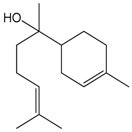 Bisabolol | Rat smooth muscle from vascular and non-vascular | 1–1000 μmol/L | Relaxation by acting in Ca2+ voltagem-dependent channel | [49] |
| Porcine splenic artery and coronary artery | 3, 10 and 30 μM | Vasodilatation by inhibiting calcium influx | [51] | |
| Rat thoracic aorta and mesenteric ring | 1–1000 μmol/L | Vasorelaxation by acting in Ca2+ voltagem-dependent channel | [50] | |
 Borneol | Human internal mammary artery | Phytotherapic preparation enriched with borneol (1 mg/mL) | Vasorelaxation with and without endothelium | [56] |
| Rat thoracic aorta artery | 10−9 to 3 × 10−4 M | Vasorelaxant effect, probably by potassium channels activation, reduction in calcium influx and inhibition of calcium mobilization from intracellular stores | [55] | |
 Carvacrol | Rat thoracic aorta artery | 1, 10 and 100 μmol L−1 | Vasorelaxant effect via inhibition of ROS and stimulation of NOS | [52] |
| Rat Cerebral and cerebellar pial Arteries | 10 and 30 μM | Vasodilatation by increase on calcium influx, by activating TRPV3 channel | [13] | |
| Rat superior mesenteric artery | 10−8 to 3 × 10−4 M | Vasorelaxation by inhibition calcium influx through the L-type Cav, ROC and SOC channels | [53] | |
| Atria isolates | 10 μM and 100 μM | Negative inotropic and chronotropic effect | [53] | |
 Carvone | Rat thoracic aorta | 100 μM | Vasorelaxation by blocking calcium influx through VDDC | [60] |
| Rat thoracic aorta and trachea of guinea pigs | 10−6 to 3 × 10−4 M | Vasorelaxant effect | [61] | |
| Rat thoracic aorta | 10−7, 10−6, 10−5, and 10−4 g/mL | Vasodilatory effect by inhibiting both Ca2+ influx and Ca2+ release | [43] | |
| Porcine coronary artery | 32–320 μM | Vasorelaxation by inhibiting Ca2+ sensitivity and Ca2+ influx | [42] | |
| Ventricular cardiomyocytes and vascular smooth muscle cells | 0.01–1000 μM | Vasorelaxing action by inhibiting L-type Ca2+ channels and possible participation of TRPA1 | [44] | |
 Cinnamaldehyde | Rat aorta artery and Human | 10 μM | Prevents endothelial dysfunction by attenuating ROS generation and | |
| umbilical vein endothelial cells (HUVECs) | preserving nitric oxide levels and Nrf2 activation and the up-regulation of downstream target proteins | [40] | ||
 Cinnamic acid | Rat thoracic Aorta | 0.1 mM, 0.2 mM, 0.4 mM, 1 mM, and 2 mM | Vasodilation via the NO–cGMP-PKG pathway, which stimulates Ca2+-activated K+ channels | [46] |
 Cinnamyl alcohol | Rat thoracic aorta artery | 0.2 mM, 0.4 mM, 0.6 mM, 1 mM or 1.5 mM | Vasodilation by activation of K+ channels and inhibition of Rho-kinase, which inhibit Ca2+ sensitization via the NO-cGMP-PKG pathway | [47] |
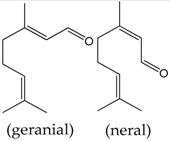 Citral (= geranial + neral) | Rat thoracic Aorta artery | 0.6 to 6 mM | Vasorelaxation by reduced the calcium influx by the blockade of voltage dependent L-type Ca2+ channels | [68] |
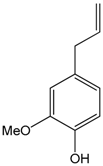 Eugenol | Rat atria Muscle | 1, 3, 5, 7, and 10 mM | Increase in resting tension by cooperative activation of cardiac thin filaments by strongly attached cross-bridges (rigor state) | [63] |
| Rat atria Muscle | 1, 3, 5, 7, and 10 mM | Increase in resting tension by cooperative activation of cardiac thin filaments by strongly attached cross-bridges (rigor state) | ||
| Rat thoracic aorta artery | 1, 10 and 100 μmol L−1 | Vasorelaxant effect via inhibition of ROS and stimulation of NOS | [52] | |
| Rat thoracic aorta artery | 100 μM | Vasorelaxation by inhibiting ROS and elevating NO | [60] | |
| Rat cerebral artery | 100 μM | Vasorelaxation by inhibiting voltage-dependent Ca2+ | [63] | |
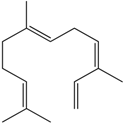 Farnesene | Porcine splenic artery and coronary artery | 3, 10 and 30 μM | Vasodilatation by inhibiting calcium influx | [51] |
 Limonene | Rat thoracic aorta and trachea of guinea pigs | 10−6 to 3 × 10−4 M | Vasorelaxant effect | [61] |
 Linalool | Rat thoracic aorta | 500 μM | Vasorelaxation by activating sGC and K+ channels and by inhibiting Ca2+ influx | [73] |
| Rat thoracic aorta | 100 μM | Vasorelaxation by blocking voltage dependent calcium channel (VDCC) and elevating NO | [60] | |
 Linalyl acetate | The mouse vascular smooth muscle cell line MOVAS-1 (MOVAS) and human umbilical vein endothelial cell line EA.hy926 (EA) | 0.01% v/v | Increase the intracellular K+ levels | [74] |
 Menthol | Rat aorta, mesenteric and coronary arteries | 0.01-1 mM | Vasorelaxation through inhibiting Ca2+ influx via nifedipine-sensitive Ca2+ channels in vascular smooth muscle | [76] |
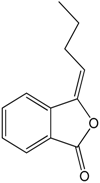 N-Butylidenephtalide | Human umbilical vein endothelial cells (HUVECs) | 20–50 μg/mL | Anti-angiogenic activities by increase of maintaining cell cycle on G0–G1 phase, and promoting apoptosis | [77] |
 Rotundifolone | Rat superior mesenteric artery | 10−7 to 3 × 10−3 M | Vasorelaxation through activation of BKCa channels and by the inhibition of Ca2+ entry through L-type Ca2+ channels | [81] |
| Compound | Model | Dose | Effects | Reference |
|---|---|---|---|---|
 1-Nitro-phenylethane | Spontaneously hypertensive rats (SHR) | 1–10 mg/kg | Promotes bradycardic and hypotensive responses after in bolus application. The mechanism suggested is by cholinergic and vagal reflex activation | [65] |
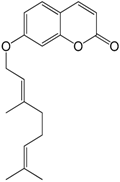 Auraptene | DOCA-salt hypertensive rats | 2–16 mg/kg/day | Decrease of blood pressure dose and time dependent | [67] |
 Borneol | Transient cerebral ischemia by intraluminal middle cerebral artery occlusion (MCAO) | 0.8 mg/kg | Decrease of pro-inflammatory markers and infarct area. Antioxidant proprieties of borneol were associated with these effects | [57] |
 Carvacrol | Wistar rats | 1–20 mg/kg | Hypotension and bradycardic effects associated with a decrease in heart rate, in a dose-dependent manner | [53] |
 Cinnamaldehyde | Isoproterenol model of myocardial ischemia | 22.5, 45 and 90 mg/kg | Decrease of cardiac injury and pro-inflammatory cytokines after per-treatment (14 days), additionally an increase of NO and SOD levels of heart tissue | [14] |
 Cinnamic acid | Isoproterenol model of myocardial ischemia | 37.5, 75 and 150 mg/kg | Decrease of biochemical markers of myocardial infarct and increase of NO levels. Indicating antioxidant proprieties of CD | [14] |
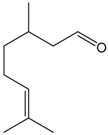 Citronellal | l-NAME hypertensive and normotensive rats | 5, 10, 20, and 40 mg/kg in bolus and 200 mg/kg orally | In bolus promotes hypotensive and bradycardic effects of normotensive rats. Treatment of l-NAME hypertensive rats promotes decrease of MAP. The results suggest that muscarinic receptors could be involved | [82] |
 Linalool | Normotensive rat | 1–20 mg/kg | They evaluate the essential oil of Rosewood enriched with linalool. In bolus treatment promotes biphasic hypotension and bradycardic responses by vagal reflex and cholinergic mechanism | [72] |
 α-Terpineol | l-NAME hypertensive rats | 25–100 mg/kg/day | Cardioprotective effect by induced hypotension and antioxidant potential by restoring antioxidant enzyme activities (catalase and glutathione peroxidase) | [80] |
 Thymoquinone | Airway inflammation by acute exposure to diesel exhaust particles (DEP) | 0.01–0.1 mg/mL | Pre-treatment with thymoquinone prevents the worse effects promoted by DEP such as leukocytosis, increase of IL-6 and decrease of SOD plasma activity. The platelet numbers and prothrombotic events were also decreased | [34] |
| Isoproterenol model of myocardial ischemia | 12.5–50 mg/kg | Antioxidant and Cardioprotective effects by decrease of LDH levels and TBARS activity. The SOD activity was increased to almost normal levels. The GSH/GSSG ratio decreased gradually and returned to near normal levels with corresponding increases in the dose | [35] | |
| Abdominal aorta ischemia followed by reperfusion (I/R) | 20 mg/kg | Reduction of oxidative stress determined by Total Oxidant Status and Oxidative Stress Index in blood samples. Decreased of histopathologic injury in in lung, renal, and heart tissues | [33] | |
 1,8-Cineole | Systolic blood pressure measured in rats | 0.1 mg/kg | Antihypertensive activity associated with the regulation of nitric oxide and oxidative stress in rats chronically exposed to nicotine | [83] |
© 2017 by the authors. Licensee MDPI, Basel, Switzerland. This article is an open access article distributed under the terms and conditions of the Creative Commons Attribution (CC BY) license (http://creativecommons.org/licenses/by/4.0/).
Share and Cite
De Andrade, T.U.; Brasil, G.A.; Endringer, D.C.; Da Nóbrega, F.R.; De Sousa, D.P. Cardiovascular Activity of the Chemical Constituents of Essential Oils. Molecules 2017, 22, 1539. https://doi.org/10.3390/molecules22091539
De Andrade TU, Brasil GA, Endringer DC, Da Nóbrega FR, De Sousa DP. Cardiovascular Activity of the Chemical Constituents of Essential Oils. Molecules. 2017; 22(9):1539. https://doi.org/10.3390/molecules22091539
Chicago/Turabian StyleDe Andrade, Tadeu Uggere, Girlandia Alexandre Brasil, Denise Coutinho Endringer, Flávio Rogério Da Nóbrega, and Damião Pergentino De Sousa. 2017. "Cardiovascular Activity of the Chemical Constituents of Essential Oils" Molecules 22, no. 9: 1539. https://doi.org/10.3390/molecules22091539
APA StyleDe Andrade, T. U., Brasil, G. A., Endringer, D. C., Da Nóbrega, F. R., & De Sousa, D. P. (2017). Cardiovascular Activity of the Chemical Constituents of Essential Oils. Molecules, 22(9), 1539. https://doi.org/10.3390/molecules22091539







